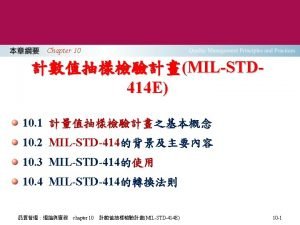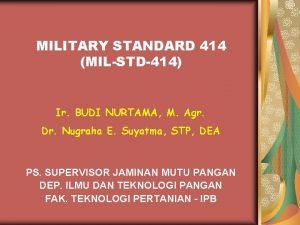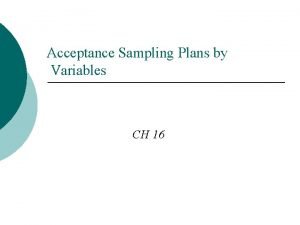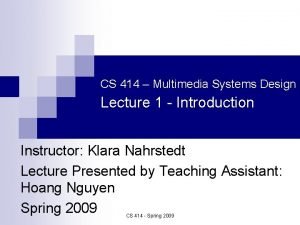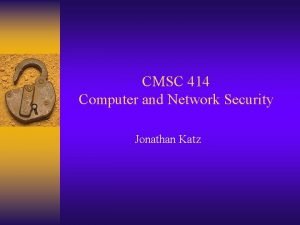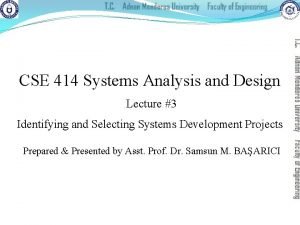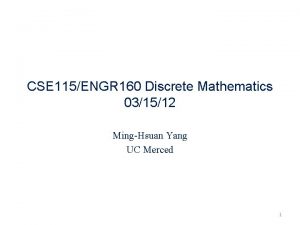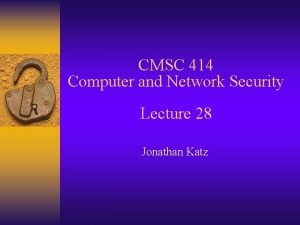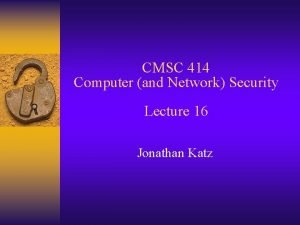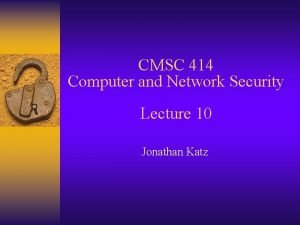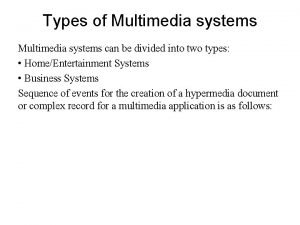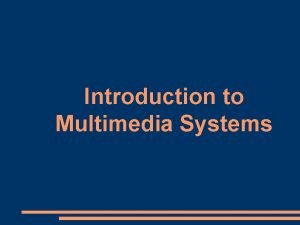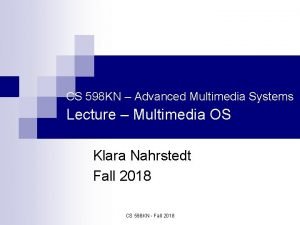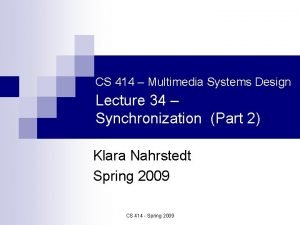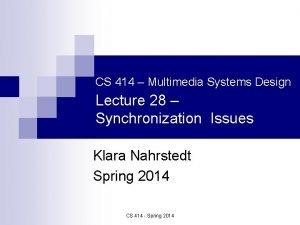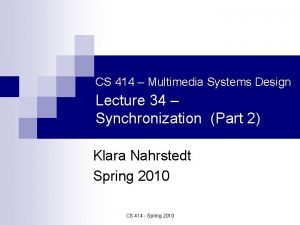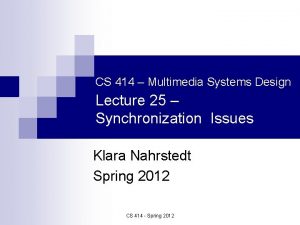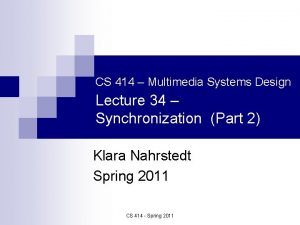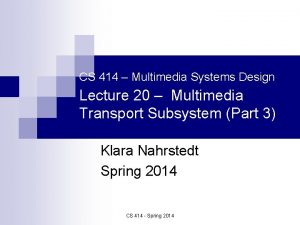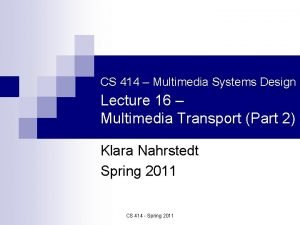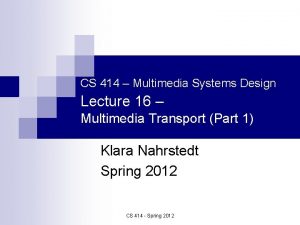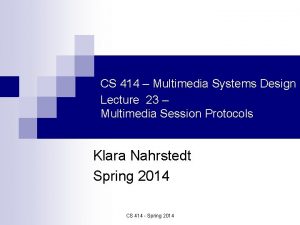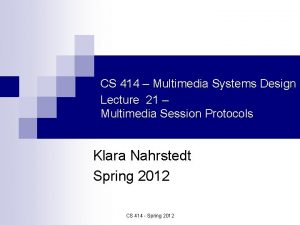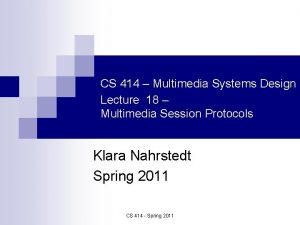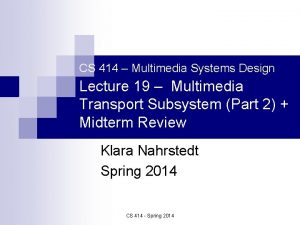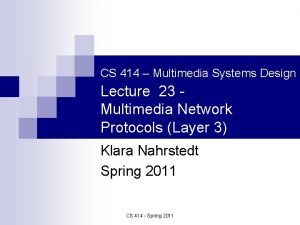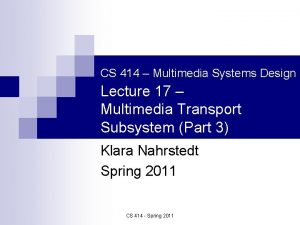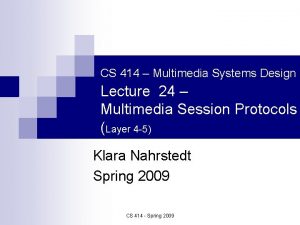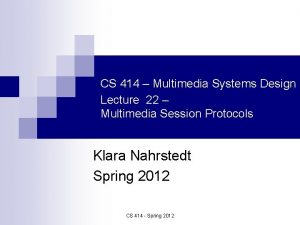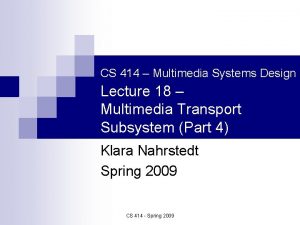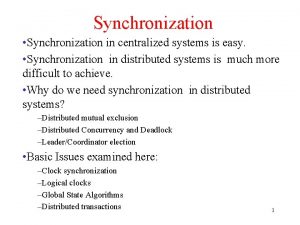CS 414 Multimedia Systems Design Lecture 33 Synchronization






















- Slides: 22

CS 414 – Multimedia Systems Design Lecture 33 – Synchronization (Part 1) Klara Nahrstedt Spring 2010 CS 414 - Spring 2010

Administrative n MP 4 posted ¨ May 1 grading 3 -5 pm ¨ May 3 competition for finalists 5 -7 pm n Peer Evaluation ¨ Deadline May 7, 5 pm – very important 5% of your grade ¨ Website will have all the instructions about the peerevaluation (see also the first lecture of the semester that discussed peer evaluation) CS 414 - Spring 2010

Outline Synchronization Concept n Synchronization Classification n Logical Data Units n Live vs Synthetic Synchronization n Synchronization Requirements n CS 414 - Spring 2010

Notion of Synchronization n Sync in correspondence to ¨ Content relation ¨ Spatial relation ¨ Temporal relation n Content Relation ¨ Define dependency of media objects for some data ¨ Example: dependency between spreadsheet and graphics that represent data listed in spreadsheet CS 414 - Spring 2010

Spatial Relation n Layout relation ¨ Defines space used for presentation of media object on output device at certain point of multimedia presentation ¨ Example: desktop publishing n Layout frames ¨ Placed on output device and content assigned to frame ¨ Positioning of layout frames: n n n Fixed to position of document Fixed to position on page Relative to position of other frame ¨ Example: in window-based system, layout frames correspond to windows and video can be positioned in window CS 414 - Spring 2010

Temporal Relation (Our focus!!!) n n n Defines temporal dependencies between media objects Example: lip synchronization Time-dependent object ¨ n Time-independent object ¨ n Media stream since there exist temporal relations between consecutive units of the stream Traditional medium such as text or images Temporal synchronization Relation between time-dependent and time-independent objects ¨ Example: audio/video sync with slide show ¨ CS 414 - Spring 2010

Temporal Relations n n Synchronization considered at several levels of Multimedia Systems Level 1: OS and lower level communication layers CPU scheduling, semaphores during IPC, traffic shaping network scheduling ¨ Objective: avoid jitter at presentation time of one stream ¨ n Level 2: Middleware/Session layer (Run-time) Synchronization of multimedia streams (schedulers) ¨ Objective: bounded skews between various streams ¨ n Level 3: Application layer (Run-time) Support for synchronization between time-dependent and timeindependent media together with handling of user interaction ¨ Objective: bounded skews between time-dependent and timeindependent media ¨ CS 414 - Spring 2010

Synchronization Specification n Implicit Temporal relation specified implicitly during capturing of media objects ¨ Goal: use this temporal relation to present media in the same way as they were originally captured ¨ Example: Audio and Video recording and playback ¨ n Explicit Temporal relation specified explicitly to define dependency in case media objects were created independently ¨ Example: creation of slide show n Presentation designer ¨ ¨ ¨ selects slides, creates audio objects, defines units of audio presentation stream where slides have to be presented CS 414 - Spring 2010

Logical Data Units and their Classification n n Time-dependent presentation units are called logical data units (LDU)s. LDU classification ¨ Open ¨ Closed n LDUs important ¨ In specification of synchronization CS 414 - Spring 2010

Synchronization Classification n Intra-object Synchronization ¨ n Time relation between various presentation units of one timedependent media stream Inter-object Synchronization ¨ Time relation between media objects belonging to two dime dependent media streams CS 414 - Spring 2010

Synchronization Classification n Live Synchronization ¨ Goal: exactly reproduce at presentation temporal relations as they existed during capturing process ¨ Requirement: must capture temporal relation information during media capturing ¨ Example: video conference, phone service ¨ Example: recording and retrieval services – presentations with delay CS 414 - Spring 2010

Synchronization Classification n Synthetic Synchronization Goal: arrange stored data objects to provide new combined multimedia objects via artificial temporal relations ¨ Requirements: support flexible synchronization relations between media ¨ Example: authoring, tutoring systems ¨ n Two phases: ¨ Specification n phase – define temporal relations ¨ Presentation phase – present data in sync mode Example: ¨ 4 audio messages recorded related to parts of engine in animation. Animation sequence shows a slow 360 degree rotation of engine CS 414 - Spring 2010

Synchronization Requirements during media presentations n For intra-object synchronization ¨ Need accuracy concerning jitter and EED delays in presentation of LDUs n For inter-object synchronization ¨ Need accuracy in parallel presentation of media objects n Implication of blocking: ¨ O. K. for time-independent media ¨ Problem for time-dependent media – gap problem CS 414 - Spring 2010

Gap Problem in Synchronization n What does blocking of stream mean for output device? Should we repeat previous music, speech, picture? ¨ How long should such gap exist? ¨ n Solution 1: restricted blocking method Switch output device to last picture as still picture ¨ Switch output device to alternative presentation if gap between late video and audio exceeds predefined threshold ¨ n Solution 2: resample stream Speed up or slow down streams ¨ Off-line re-sampling – used after capturing of media streams with independent streams ¨ n ¨ Example: concert which is captured with two independent audio/video devices Online re-sampling – used during presentation in case gap between media streams occurs CS 414 - Spring 2010

Lip Synchronization n n Temporal relation between audio and video Synchronization skew ¨ Time difference between related audio and video LDUs Streams in sync iff skew = 0 or skew ≤bound Negative skew: video before audio Positive skew: Audio before video CS 414 - Spring 2010

Lip Synchronization Perception of Synchronization Errors Skew Level found to be annoying CS 414 - Spring 2010

Lip Synchronization Requirements n In sync: ¨ n -80 ms ≤ skew ≤ 80 ms Out of sync: ¨ Skew < -160 ms ¨ Skew > 160 ms n Transient: ¨ -160 ms ≤ skew < -80 ms ¨ 80 ms < skew ≤ 160 ms CS 414 - Spring 2010

Pointer Synchronization Pointer Sync based on technical drawing CS 414 - Spring 2010 Pointer Sync based on map

Pointer Synchronization Negative skew: pointer before audio Positive skew: pointer after audio CS 414 - Spring 2010

Pointer Synchronization Requirements n In sync: ¨ -500 ms n ≤ skew ≤ 750 ms Out of sync: ¨ Skew < -1000 ms ¨ Skew > 1250 ms n Transient sync situation: ¨ -1000 ms ≤ skew < -500 ms ¨ 750 ms < skew ≤ 1250 ms CS 414 - Spring 2010

Other Sync Requirements n Jitter delay of digital audio ¨ n Max. allowable jitter: n 5 -10 ns (perception experiments) n 2 ms (other experiments) Combination of audio and animation Not stringent as lip sync ¨ Max allowable skew: +/- 80 ms ¨ n Stereo audio Tightly coupled ¨ Max allowable skew: 20 ms ¨ Due to listening errors, suggestion even +/- 11 ms ¨ n Loosely coupled audio channels (speaker and background music) ¨ Max allowable skew: 500 ms CS 414 - Spring 2010

Conclusion Carefully analyze what kind of synchronization is needed in your multimedia system and application n Determine at which level you need synchronization n Determine what the synchronization requirements should be based on prior experiments n CS 414 - Spring 2010
 Clock synchronization in distributed system
Clock synchronization in distributed system 01:640:244 lecture notes - lecture 15: plat, idah, farad
01:640:244 lecture notes - lecture 15: plat, idah, farad Multimedia becomes interactive multimedia when
Multimedia becomes interactive multimedia when Disadvantages of linear multimedia
Disadvantages of linear multimedia Csc253
Csc253 Esa multimedia.esa.int./multimedia/virtual-tour-iss
Esa multimedia.esa.int./multimedia/virtual-tour-iss 0 414
0 414 Military standard 414
Military standard 414 Mil std 414
Mil std 414 Pc 414
Pc 414 Cs 414
Cs 414 Cmsc 414
Cmsc 414 Cse 414
Cse 414 Gcd of 414 and 662
Gcd of 414 and 662 Cmsc 414
Cmsc 414 Cmsc 414
Cmsc 414 Cmsc 414
Cmsc 414 Operating systems lecture notes
Operating systems lecture notes Articulators
Articulators Lecture sound systems
Lecture sound systems Types of multimedia system
Types of multimedia system Introduction of multimedia
Introduction of multimedia Cs598
Cs598






